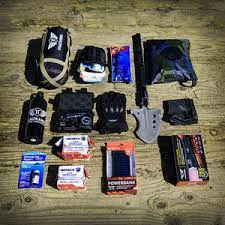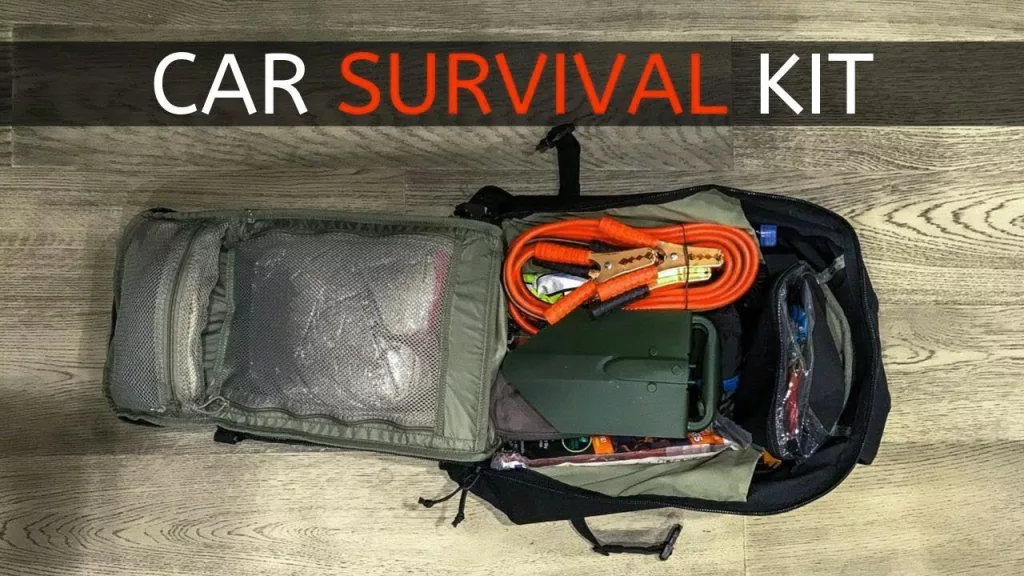The Importance of a Car Survival Kit
Picture yourself stuck on a empty road in a big snowstorm with no phone signal and less gas. The wind blows loudly, and it gets very cold. Fear and uncertainty grip you. Now imagine pulling out a neatly packed car survival kit from the trunk. It’s a symbol of hope in all that mess. This kit, put together very carefully before use, contains the important things you need to stay warm and safe until help comes.
A survival kit for a car is not just something to rely on in case of bad luck; it’s spending money so you feel better. It gives you the courage and smarts to deal with unexpected problems. You know you have what it takes to handle simple car issues or survive tough times for extended periods.

Recognizing Potential Emergency Situations on the Road
We all wish for no problems on every trip, but the truth is that life can give us surprises. Here are some common emergency situations where a car survival kit can be your lifesaver:
• Mechanical breakdowns: Car problems, punctured tires and a dead battery are all part of the unexpected things that can happen with vehicles. A car kit helps you fix little problems or show for help well on your own.
• Extreme weather: Bad weather like blizzards, floods and very hot heat can be dangerous if you are caught in it. Your car kit for safety should have important things like warmth, water and cover to get through bad weather.
• Accidents: Even though we hope it never happens, accidents are a tough fact on the road. A good car survival kit full of things can be very helpful. It can give you first aid, let people know you need help and keep you safe until big helpers come.
• Getting lost: Sometimes, technology can let us down and even the best sailor might be confused. A car kit with basic tools for finding your way and emergency stuff can help you stay calm until you get back on the right path.

Assessing Your Driving Environment: Gear Up for the Road Ahead
Before we look at certain things, it’s really important to think about the special place you go each day. Your car safety kit is a part of being ready, and like any good explorer, you change things to match the place and issues you imagine will happen. Let’s unpack this crucial step in crafting your personalized kit:
Making Your Kit Adapt to Local Weather Conditions.
Nature can cause many different problems and your car kit should be ready to deal with them. Is your normal drive a sunny desert road? Use a lot of sun protection, have things to keep you from feeling too hot and get a strong cover for the sun on your car. Are you dealing with winter’s cold hands? In winter, use things like emergency blankets, warm clothes and strong flashlights to stay safe.
• Consider the extremes: Search for normal weather habits and history in the area you live. Does flash floods, blizzards or very hot weather happen often? Pack accordingly.
• Layers are key: Buy clothes that you can put on or take off to cope with different weather situations.
• Don’t underestimate hydration: Take more water with you and consider using water cleaning pills if you travel to distant places.
Thinking about terrain and remote places when planning your travel.
Are your travels a beautiful dance through twisty mountain roads or a boring push on flat, open roads? The terrain you conquer dictates what tools you need in your arsenal:
Mountain mavericks: Bring tire chains, traction mats and a first-aid kit ready for possible altitude sickness problems.
Desert dwellers: Get ready for hot weather with a car sunshade, a portable fan, and tire pressure gauge (heat makes tires expand!).
Off-road adventurers: A winch, tow rope and recovery gear could be your best help in far away places.
Checking for Dangers on Your Drive Paths
Even easy roads can have secret risks. Analyze your regular commute and identify potential risk areas:
Construction zones: Get ready for stops and slow-downs by bringing snacks, fun things to do, and a charged phone.
High-traffic areas: Bring a emergency triangle and reflective vests for being seen on the road in case of breaking down.
Animal crossings: Bring a first-aid kit and learn what to do if you meet animals in the wild.
By considering these things, you will create a strong car emergency kit. It won’t just be regular, but made to manage the problems your driving place gives you. Don’t forget, being ready is strong and having a kit made just for you gives you that strength on the road.
Essential Tools for Vehicle Maintenance: Master Mechanics, Unite!
Sometimes even a good car can have problems. That’s where these essential tools come in, turning you from a helpless driver into a road-ready MacGyver:
Extra Wheel, Lift Device and Tire Wrench
The three important fixes on the road, this set is not optional. Make sure your extra tire has enough air and you know how to use the jack and wrench safely. Think about buying a small, simple jack to make things easier.
Use jumper cables for battery problems.
A flat battery can change a fast trip into a long day. Keep a good quality pair of jumper cables in your car’s trunk. Check the amperage rating for your car and learn how to use them safely. Keep in mind, always avoid linking good things with bad.
Basic Car Repair Tools: Screwdriver, Pliers, and Wrench
These helpful things can fix a lot of small car problems. Bring a simple collection of screwdrivers (flat and Phillips), pliers, and different sizes of wrench with you. A multi-tool can also save space.
Keep in mind, knowing the basics can take you far. Get used to using these tools and learn common car care tasks you can do by yourself. With this knowledge and basic tools, you can handle many small roadside problems with confidence. This will save you from the trouble and cost of needing help.
Emergency Communication Devices: Stay Connected When the Grid Goes Down
When problems come, staying linked can make a big difference between an okay situation and a major mess. You need the right tools in your car kit to ask for help, get important information and show you need aide. This works even when there is little or no phone service.
Portable Phone Charger or Power Bank:
We have to admit, in today’s world our phones are very important. A phone that is not working during an emergency can be very bad. Bring a small charger or power source that has enough battery to keep your phone working for long times. Pick one that has lots of places to plug in other gadgets like GPS or headlights. Don’t forget to charge the power bank itself!
Emergency Radios for Updates and Alerts:
Even if cell towers are not working, radio waves can still find a way through the noise. Buy a hand-crank emergency radio that collects AM/FM and NOAA weather channels. These radios usually have built-in flashlights and phone chargers, making them useful for many things.
First Aid and Medical Supplies: Be Your Own Mini-Medic
When accidents happen, it’s important to be ready for small injuries. This can help a lot. Your car survival kit should be a mini medical arsenal:
Basic First Aid Kit with Bandages and Antiseptic:
Think cuts, scrapes, and burns. Put together a good first-aid kit with different size sticky bandages, cotton pads, cleaning wipes and things to close wounds. Remember to pack pain medicine, tweezers, and safety pins. You could add CPR gloves and an emergency blanket for extra readiness.
Over-the-Counter Medications for Common Ailments:
Headaches, stomach upset and allergies can mess up even the best plans. Bring some common medicines like ibuprofen, antihistamines and antacids with you. Make sure to pack personal medicine for long-term health problems, and always check when it expires!
Personal Prescription Medications and Medical Information:
This one’s crucial. If you use prescription medicines, make sure you have enough for your trip and extra time in case of unplanned delays. Put them in their first containers with easy-to-read labels. Think about keeping a health info card that tells what you are allergic to, any conditions you have already and who to call in an emergency.
Conclusion: Be Road-Ready, Be Safe, Be Prepared
Making your full car safety kit is more than just ticking things on a list; it’s putting money into making you safe and relaxed. By making your kit just for where you drive, bringing important tools and ways to talk with others, and giving more importance to first-aid kits and medical supplies, you can handle many unexpected things while driving.
Remember, your car emergency kit is not something that doesn’t change. Keep it fresh by changing it often as your wants and way of driving change. Look at when things are outdated, change old stuff and make your goods match the seasons or trips you have planned. Most importantly, learn what is in your kit and how to use them. Knowing things is important, and using your tools right can help turn a small problem into a big one.
FAQs:
How often should I replace my automobile survival package?
Ideally, evaluation your package earlier than long trips and at least seasonally. Check expiration dates, update used objects, and adapt your substances to the upcoming weather and capacity using situations.
What extra items have to I recollect for unique climates?
For warm climates, percent sunscreen, a hat, and a portable fan. For bloodless climates, consist of thermal apparel, hand warmers, and an emergency blanket. In regions with excessive rainfall, keep in mind rain equipment and a windshield scraper.
Is there a prison requirement to have a automobile survival kit?
While no longer legally mandated in maximum areas, having a vehicle survival kit is strongly encouraged by way of protection experts. It’s your personal safety net in case of emergencies.
Where ought to I keep my vehicle survival package?
Keep your package without difficulty accessible however steady. A strong field under the seat or within the trunk is good. Avoid storing it in direct daylight or excessive temperatures.
